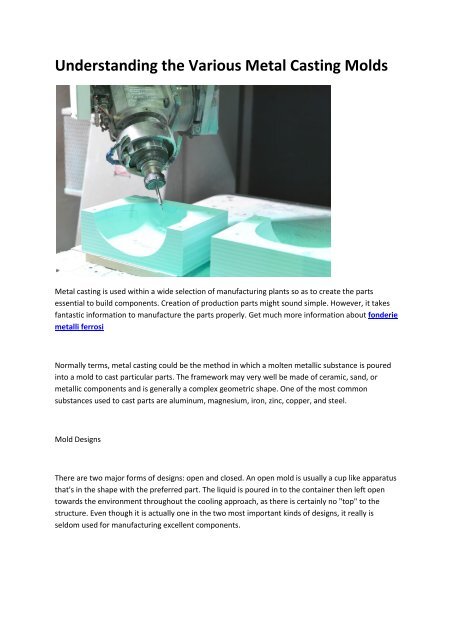5 lavorazione metalli non ferrosi
You also want an ePaper? Increase the reach of your titles
YUMPU automatically turns print PDFs into web optimized ePapers that Google loves.
Understanding the Various Metal Casting Molds<br />
Metal casting is used within a wide selection of manufacturing plants so as to create the parts<br />
essential to build components. Creation of production parts might sound simple. However, it takes<br />
fantastic information to manufacture the parts properly. Get much more information about fonderie<br />
<strong>metalli</strong> <strong>ferrosi</strong><br />
Normally terms, metal casting could be the method in which a molten <strong>metalli</strong>c substance is poured<br />
into a mold to cast particular parts. The framework may very well be made of ceramic, sand, or<br />
<strong>metalli</strong>c components and is generally a complex geometric shape. One of the most common<br />
substances used to cast parts are aluminum, magnesium, iron, zinc, copper, and steel.<br />
Mold Designs<br />
There are two major forms of designs: open and closed. An open mold is usually a cup like apparatus<br />
that's in the shape with the preferred part. The liquid is poured in to the container then left open<br />
towards the environment throughout the cooling approach, as there is certainly no "top" to the<br />
structure. Even though it is actually one in the two most important kinds of designs, it really is<br />
seldom used for manufacturing excellent components.
The other variety of design is known as the closed mold. This design has a delivery system, enabling<br />
you to pour the liquid into the structure. The liquid just isn't exposed for the elements throughout<br />
the cooling process. These frameworks are used in part manufacturing.<br />
There is certainly one other design that is definitely used in only special cases. It's known as the core.<br />
Some components require an internal geometric pattern and that is certainly what this can be used<br />
for. Like a traditional building, the core is an inverse replica of the component needed. During the<br />
metal casting procedure, the core remains inside the structure and might be supported by chaplets<br />
to stop moving or shifting.<br />
Mold Forms<br />
When you make a metal casting structure, you'll be able to either pick to create a permanent or<br />
expendable frame. They are just as they sound, and every single has their benefits.<br />
A permanent building might be used to manufacture any aspect. Typically, they are constructed<br />
from a <strong>metalli</strong>c element or ceramic. They are designed to be opened and closed to ensure that you<br />
could effortlessly get rid of the components. Because they're reusable, they will save money. These<br />
do possess a downside, as you might be limited on the designs you make mainly because they have<br />
to be opened and closed.<br />
Expendable options give you a chance to create much more intricate geometric shapes to cast.<br />
These forms are made of sand, plaster, or maybe a similar material. However, these can only be<br />
used once for the reason that you may have to destroy them to have the portion out. This can grow<br />
to be highly-priced over time.<br />
To be able to manufacture several components of your very same design using an expendable<br />
model, you need to have a pattern on the interior cavities in order to remake the frame. This pattern<br />
is generally created of wood, plastic, aluminum, steel, or cast iron. It truly is coated with a releasing<br />
agent that makes it possible for the expendable frame to be simply removed.<br />
Metal casting molds is often created in all shapes and sizes. Try to remember that you just should<br />
slightly oversize any frame and pattern to enable for the shrinkage that can occur during the<br />
solidification procedure.

















